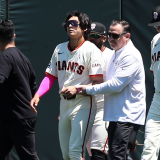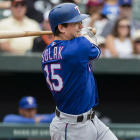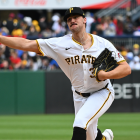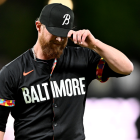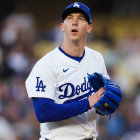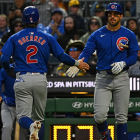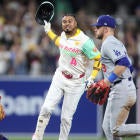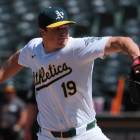With the regular season concluding, we've decided to take a look at each team's future -- not by using a crystal ball or other psychic abilities, but by evaluating their farm systems. Below you'll find our ranking of the top five prospects in the organization -- sorted by perceived future potential -- as well as five other players who fit various categories. Those categories are:
2020 contributor: A player who is likely to play a role for the big-league team next season.
Analyst's pick: A player who is a strong statistical performer and/or whose underlying measures are better than the scouting reports suggest.
Riser: A player on the way up.
Faller: A player on the way down.
One to watch: An interesting player to keep in mind (for whatever reason).
These rankings were compiled after talking with various industry sources about the systems (and players) in question. It should be acknowledged that this process is more art than science, and that there are limits to ordinal rankings. Still, it's an intuitive system, and our hope is that the write-ups will answer any questions by providing additional context and analysis of each player -- such as their pluses and minuses; the risk factors involved; and their estimated arrival date.
One last word on eligibility: we're following MLB's rookie guidelines by disqualifying any player with more than 130 big-league at-bats or 50 innings pitched.
The Texas Rangers don't have the best farm system in baseball by any means. They do have some intriguing prospects who, with a good season, could make the organization look better than it does right now, however. They've also made some savvy trades to add talent over the past two years, including their No. 1 ranked prospect Nick Solak.
1. Nick Solak, 2B
The Rangers acquired Nick Solak in July from the Rays, who had shopped him around due to his perceived defensive limitations. One source familiar with the Rays' internal evaluation said the club felt he was a "double-negative" defender at the keystone -- meaning well-below average. A scout from another team agreed with that assessment, but Solak is regarded as a hard worker and it's possible he improves enough to be playable there for a time.
Regardless of Solak's defense, he can hit and he can run. He has a simple swing and a discerning approach at the dish, a combination that should allow him to pitch in across the board. (He is going to strike out a fair amount just by virtue of working deep counts so often.) Solak didn't run much in the majors, but he stole 21 bases as recently as 2018 and posted a sprint speed in the 85th percentile. Heading forward, he's a candidate for at least 10-plus thefts.
Solak's landing spot on the diamond will dictate his overall value, but there's ample reason to believe he could be the Rangers' everyday second baseman in 2020 -- and that he's at the onset of what's likely to be a lengthy big-league career.
2. Josh Jung, 3B
The No. 8 pick in June's draft, Josh Jung is the 2019 draftee most likely to be mentioned as a swing-change candidate for the foreseeable future.
The reason for that is straightforward: Jung is a well-constructed third baseman who didn't offer much power as a collegiate (where he topped out at 14 home runs) and who finished his first 44-game professional stretch with a .127 ISO.
Being fair to Jung, he did walk more than he struck out in two of his three collegiate seasons, but it's hard to be a hit-over-power third baseman these days. To wit, just three of the 33 players who received more than 300 plate appearances and played at least half their games at the hot corner had an ISO lower than .150 in 2019 -- and two of them finished with less than one Win Above Replacement.
Maybe Jung can make the necessary adjustments in the coming years, but it's worth being skeptical about his profile based on what he's done as an amateur and (thus far) as a pro.
3. Sam Huff, C
You can make the argument that no player in the Rangers system more improved their standing in 2019 than Sam Huff did.
Huff homered 28 times between Single- and High-A, and did so while continuing to grade well per teams' internal framing metrics -- thus providing the Rangers with incentive to keep him behind the plate, even if he is on the large side for a backstop (6-foot-4 and 230 pounds). Huff does strike out a lot, making him an attrition risk as he ascends the latter if his swing-and-miss issues get out of hand. He also doesn't walk much, which limits his overall offensive ceiling.
The best-case scenario here is that Huff provides enough pop and framing to resemble Mike Zunino's best years in Seattle -- or, Tom Murphy's best (and so far only) year in Seattle.
4. Leody Taveras, OF
It feels like Leody Taveras has been around forever, given he signed back in July 2015, yet he'll play all of next season as a 21-year-old.
Taveras split 2019 between High- and Double-A, improving his upon his so-so performance the year prior before being moved up to the penultimate minor-league level. Predictably, his numbers slipped after the promotion, as he walked less often and boasted a worse average. (He did show more power and strike out less, however.)
While Taveras is a switch-hitter, he's consistently been better from the left side of the plate -- a trend that, if one must exist, is more welcomed than the inverse would be. He has all the tools to be an impact-level center fielder and baserunner, though he'll need to continue to improve his efficiency as it pertains to stealing bases -- he's around 70 percent for his career.
Taveras is at least another year away from being ready for primetime. The development of his bat will dictate if he's a top- or bottom-of-the-order hitter.
5. Cole Winn, RHP
The Rangers drafted Cole Winn with the No. 15 pick in 2018 believing they were getting a polished, potentially quick-moving prep arm who has a good fastball-curveball combination and better-than-average command.
Unfortunately, that didn't appear to be the case during Winn's first full professional season.
Rather, Winn started 18 times in A-ball and finished the year with a 4.46 ERA. More concerning was the fact he issued more than five walks per nine innings -- a troubling sign for someone whose feel for throwing strikes was one of the top selling points.
There's no sense giving up on Winn just yet, but this was a surprising way for him to begin his career -- and not in a good way. If he can right the ship in 2020, he'll be back en route to becoming a mid-rotation starter. Otherwise, he'll be listed in the "faller" category.
2020 contributor: Brock Burke, LHP
Like Solak, Brock Burke was acquired from the Rays over the past year. Unlike Solak, Burke's introduction to the majors went poorly. Billed as a four-pitch southpaw with two potential plus secondaries, he struggled to miss bats -- to the extent that his 13.1 percent whiff rate was the third-lowest among pitchers with at least 100 batters faced, per Statcast, ahead of only Erc Skoglund and Dan Otero. That's not ideal. Burke's game score also declined in each of his final five starts. That, too, is not ideal. Oh, and he missed time with a shoulder impingement. You get the bit by now. Anyway, he should get more of a look in 2020.
Analyst's pick: Tyler Phillips, RHP
Tyler Phillips is a changeup artist who had been stubborn with walks and home runs until reaching Double-A, where he yielded 15 dingers in 93 innings. That's noteworthy, since he'd surrendered 17 home runs in his first 343 professional innings. Phillips made a late-season arsenal tweak, implementing a slider that could usurp his curveball as his go-to breaking ball. If the slider develops into an average or better pitch he should be at least a back-end starter.
Riser: Sherten Apostel, 3B/1B
Part of the return on Keone Kela, Sherten Apostel improved his stock by hitting .251/.339/.440 across Single- and High-A while being a couple years younger than his average opponent. His strikeout rate ballooned in High-A, and it'll be worth monitoring if he can suppress it again with increased exposure to advanced pitching. Offensively, he's likely to end up as a power-over-hit bat who walks at a healthy rate -- or, possibly, a three-true-outcomes type. Defensively, Apostel is already what one might call a Big Lad (6-foot-4, 200 pounds) and there's a strong likelihood he's going to end up shifting across the diamond to first base before he turns 25.
Faller: Chris Seise, SS
The No. 29 pick in the 2017 draft, Chris Seise finds himself here because of injury. He missed all of 2018 recovering from rotator cuff surgery on his throwing shoulder. This season, he tallied 92 plate appearances before tearing his labrum in his other shoulder, requiring another season-ending operation. Health is said to be the sixth tool, and one Seise heretofore has lacked. Here's hoping he's hearty and hale in 2020.
One to watch: Ronny Henriquez, RHP
Ronny Henriquez is a walking attrition risk. He's listed at 5-foot-10, 155 pounds and he won't turn 20 until next June. But he has a fast arm and grades well so far as spin rates are concerned. Is he the next Luis Patino or Sixto Sanchez? Probably not. But he's a name to keep in mind, and one that quant-heavy teams will likely badger the Rangers about in trade talks.







